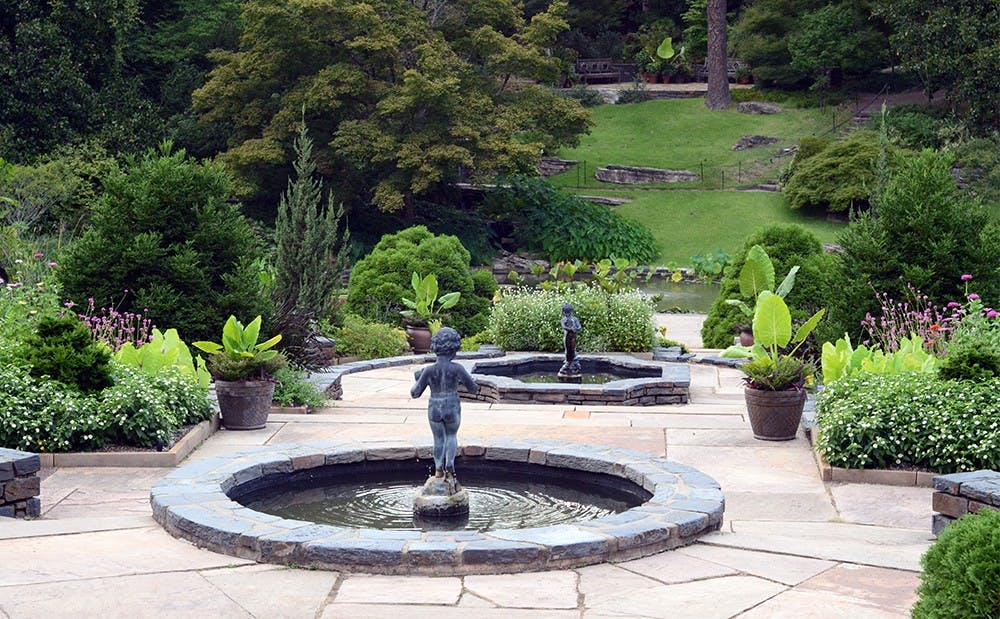As expected during the calm of Spring Break, campus was eerily empty. Even the ebb and flow of p-frosh, their families and members of the Durham community walking on the grounds in nearly perfect weather made only but a subtle hum. Honestly, it seemed as if the only place on campus during the break inhabited by life, both people and foliage, was the Duke Gardens and its annual natural art exhibition.
From March 12 to 16, the Gardens held the Third Annual Art and Nature Exhibit in the Doris Duke Center that showcased artists’ interpretations of the Garden’s W.L. Culberson Asiatic Arboretum. The Asiatic section of the gardens features plants indigenous to Asia such as bamboo, Japanese maples and ginger lilies all planted in Duke’s backyard. Local artists invited to participate in the event were given simple instruction: find a part of the Asiatic gardens that inspires you and capture it someway, somehow through art.
“I’ve been through the gardens a number of times looking for images suitable for my work and inspired by color,” recalled local artist Angela Burr on how she found her inspiration for the exhibition. “Most of my work is vibrant… and the bamboo was ideal because I could change color completely of bamboo and people would know what it was.”
Burr is a local self-taught artist originally from England, who has been creating art for all of her life but starting painting professionally when she came to the States 10 years ago. In the past, her work has placed second runner-up at this same exhibition.
Burr’s piece “Bamboo” and another painting “Dwarf Yunnan Banana” were among 52 other works included in the art exhibit. Immediately from the entrance of the exhibition space, Burr’s rich blue, green and yellow acrylics in “Bamboo” stand out. The painting especially experiments with textures and hues to produce a more vibrant and abstract take on the Asiatic foliage that Burr believes is a reflection of her personality.
Her piece “Dwarf Yunnan Banana” rests on a rugged canvas cut by a palette knife, which mimics the texture and appearance of the leaf’s veins—a technique she originally did not plan on using for this painting.
“I don’t plan things but I follow my instincts,” Burr reflected on her creative process. “To produce something that’s abstract, you do it impulsively rather than plan it.”
In addition to Burr’s colorful perspectives, the exhibit showcased a host of many different art styles created by people with a whole range of experience levels like drawings by fifth grade student Jenny Hu to paintings by retiree and current North Carolina Botanical Gardens at UNC-Chapel Hillart instructor Linda Koffenberger.
Koffenberger has been a lifelong student of art and recalls fostering a deep art appreciation especially when she saw a VanGogh exhibition in Portland, Oregon at the age of 11. While she primarily teaches colored pencil at UNC, she also specializes in water color and egg tempera, an older Italian art form that uses colored pigments mixed with egg yolk that was popular before the onset of oil painting and made a resurgence in the 1960s and ‘70s. Her appreciation for various art styles and forms across the globe helped shape her vision for her submission “Here Today.”
“I love the simplicity of Asian art compared to Western art,” Koffenberger said. “I would stroll around [the Gardens] and look for inspiration or something strikes me… so I could create something that all together is both simple and serenely calming, and that [for me] of course was an Asian tree.”
Koffenberger’s “Here Today” depicts a tree where a flock of wax wing birds eat its fruit. The piece utilizes colored pencil to simply depict a migrating flock of birds that in its journey southward, stopped for nourishment on the tree branches. Koffenberger explains that birds she saw were here today and would be gone tomorrow.
Unlike Burr’s more instinctual creative process, Koffenberger’s process involves more planning.
“It’s a process of problem solving and thinking through and visualizing what the story you want to convey in the picture,” Koffenberger described. “You have these pictures of birds, wax wings, on tracing paper and work to get the composition right… I didn’t really care about the number of iterations it took as long as you get something you like for the actual painting.”
Not to mention, “Here Today” took Best in Show this year. While Koffenberger was happy about her win in Best in Show, she notes that she does not do art for the awards.
“I do art for myself,” Koffenberger reflects. “I also enjoy giving to other people the chance to share something that I’ve marveled at, and that other people feel the same awe I did. We live in a world inside four walls, I don’t think people get a chance to stroll through the garden and an appreciation for the natural world. ”
While the Art and Nature Exhibition is a great outlet for local artists to showcase and sell their artwork, the visitors and patrons to the opening day of the exhibition were mesmerized by the sheer brilliance of the art pieces. A couple from China visiting Duke for a job interview stumbled upon the exhibit as they were touring the Gardens that afternoon.
“There is a color and a structure to this piece that is so beautiful,” said Lei Zhang, commenting on “Camellia.” “The drawing looks as if it is a photograph that captures the vibrant spring time feeling.”
The couple also found that what truly reverberated throughout the exhibition was was a strong respect and fusion of Asian elements within the artwork.
“I feel that there is a great mixture of multicultural and east Asian elements in these paintings and drawings,” Xiaoyu Duan noted. “But more so, it is the deep respect for nature that resonates in all of the pieces.”
Get The Chronicle straight to your inbox
Signup for our weekly newsletter. Cancel at any time.

